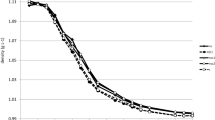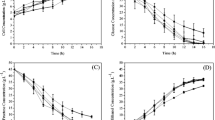Abstract
The juicing industry generates large amounts of waste that mostly lack commercial value and, in the absence of waste treatment policies, produces environmental pollution. Also, microbiological spoilage is a major concern in the wine industry and control tools are limited. Taking these challenges into account, agro-industrial waste coming from ultrafiltrated apple and pear juice were used to grow Saccharomyces eubayanus and to produce its killer toxin (SeKT). A Plackett–Burman screening was performed in order to optimize SeKT production in ultrafiltrated apple and pear juice. The optimized medium was characterized: 75% v/v WUJ, 0.5% m/v KH2PO4, 0.5% m/v MgSO4, 0.5% m/v (NH4)SO4, 0.5% g/L urea, 10% v/v glycerol and 0.1% v/v Triton X-100. SeKT produced in WUJ optimised medium was used to perform killer assays against wine spoilage yeasts and showed antagonistic activity against Brettanomyces bruxellensis, Pichia guilliermondii, Pichia manshurica and Pichia membranifaciens. Different inhibition percentages against spoilage species in a wine environment (49–69%) were detected and preserved for at least 48 h. For the first time, this work reports the ability of S. eubayanus to produce a killer toxin with potential use as a biocontrol tool in winemaking. Producing SeKT using agro-industrial waste as an alternative medium to cultivate S. eubayanus would have industrial, economic and ecological benefits.



Similar content being viewed by others
References
Ahmed S, Ahmad F, Hashmi AS (2010) Production of microbial biomass protein by sequential culture fermentation of Arachniotus sp., and Candida utilis. Pak J Bot 42:1225–1234. https://doi.org/10.1007/s13213-011-0357-8
Belda I, Ruiz J, Alonso A et al (2017) The biology of Pichia membranifaciens killer toxins. Toxins. https://doi.org/10.3390/toxins9040112
Ciani M, Fatichenti F (2001) Killer toxin of Kluyveromyces phaffii DBVPG 6076 as a biopreservative agent to control apiculate wine yeasts. J Appl Environ Microbiol 67:3058–3063. https://doi.org/10.1128/AEM.67.7.3058
Comitini F, Ciani M (2011) Kluyveromyces wickerhamii killer toxin: purification and activity towards Brettanomyces/Dekkera yeasts in grape must. FEMS Microbiol Lett 316:77–82. https://doi.org/10.1111/j.1574-6968.2010.02194.x
Comitini F, De Ingeniis J, Pepe L et al (2004) Pichia anomala and Kluyveromyces wickerhamii killer toxins as new tools against Dekkera/Brettanomyces spoilage yeasts. FEMS Microbiol Lett 238:235–240. https://doi.org/10.1016/j.femsle.2004.07.040
Divol B, Du Toit M, Duckitt E (2012) Surviving in the presence of sulphur dioxide: strategies developed by wine yeasts. Appl Microbiol Biotechnol 95:601–613. https://doi.org/10.1007/s00253-012-4186-x
González Flores M, Rodríguez ME, Oteiza JM et al (2017) Physiological characterization of Saccharomyces uvarum and Saccharomyces eubayanus from Patagonia and their potential for cidermaking. Int J Food Microbiol 249:9–17. https://doi.org/10.1016/j.ijfoodmicro.2017.02.018
Goula AM, Thymiatis K, Kaderides K (2016) Valorization of grape pomace: drying behavior and ultrasound extraction of phenolics. Food Bioprod Process 100:132–144. https://doi.org/10.1016/j.fbp.2016.06.016
Gulhane PA, Gomashe AV, Kadu K (2015) Apple pomace: a potential substrate for ethanol production. Int J Res Stud Biosci 3:110–114. https://doi.org/10.1007/s13197-010-0061-x
Labbani FZK, Turchetti B, Bennamoun L et al (2015) A novel killer protein from Pichia kluyveri isolated from an Algerian soil: purification and characterization of its in vitro activity against food and beverage spoilage yeasts. Antonie van Leeuwenhoek 107:961–970. https://doi.org/10.1007/s10482-015-0388-4
Laemmli U (1970) Cleavage of structural proteins during the assembly of the head bacteriophage T4. Nature 227:680–685. https://doi.org/10.1038/227680a0
Libkind D, Hittinger CT, Valerio E et al (2011) Microbe domestication and the identification of the wild genetic stock of lager-brewing yeast. Proc Natl Acad Sci 108:14539–14544. https://doi.org/10.1073/pnas.1105430108
Liu GL, Chi Z, Wang GY et al (2015) Yeast killer toxins, molecular mechanisms of their action and their applications. Crit Rev Biotechnol 35:222–234. https://doi.org/10.3109/07388551.2013.833582
Lopes CA, Sangorrin MP (2010) Optimization of killer assays for yeast selection protocols. Rev Argent Microbiol 42:298–306. https://doi.org/10.1590/S0325-75412010000400011
Lopes CA, Jofré V, Sangorrín MP (2009) Spoilage yeasts in Patagonian winemaking: molecular and physiological features of Pichia guilliermondii indigenous isolates. Rev Argent Microbiol 41:177–184
Lowry O, Rosbrough N, Farr A, Randall R (1951) Protein measurement with the Folin phenol reagent. J Biol Chem 193:265–270
Martínez DA, Buglione MB, Filippi MV et al (2015) Mycelial growth evaluation of Pleurotus ostreatus and Agrocybe aegerita on pear pomaces. Anal Biol 37:1–10. https://doi.org/10.6018/analesbio.37.1
Mehlomakulu NN, Setati ME, Divol B (2014) Characterization of novel killer toxins secreted by wine-related non-Saccharomyces yeasts and their action on Brettanomyces spp. Int J Food Microbiol 188:83–91. https://doi.org/10.1016/j.ijfoodmicro.2014.07.015
Mihajlovski KR, Radovanović NR, Veljović DN et al (2016) Improved β-amylase production on molasses and sugar beet pulp by a novel strain Paenibacillus chitinolyticus CKS1. Ind Crops Prod 80:115–122. https://doi.org/10.1016/j.indcrop.2015.11.025
Miller G (1959) Use of dinitrosalicylic acide agent for determination of reducing sugar. Anal Chem 31:426–428. https://doi.org/10.1021/ac60147a030
Ojha N, Das N (2018) A Statistical approach to optimize the production of polyhydroxyalkanoates from Wickerhamomyces anomalus VIT-NN01 using response surface methodology. Int J Biol Macromol 107:2157–2170. https://doi.org/10.1016/j.ijbiomac.2017.10.089
Oro L, Ciani M, Comitini F (2014) Antimicrobial activity of Metschnikowia pulcherrima on wine yeasts. J Appl Microbiol 116:1209–1217. https://doi.org/10.1111/jam.12446
Plackett R (1946) The design of optimum multifactorial experiments. Biometrika 33:305–325
Rodríguez ME, Pérez-Través L, Sangorrín MP et al (2014) Saccharomyces eubayanus and Saccharomyces uvarum associated with the fermentation of Araucaria araucana seeds in Patagonia. FEMS Yeast Res 14:948–965. https://doi.org/10.1111/1567-1364.12183
Sáez JS, Lopes CA, Kirs VC, Sangorrín MP (2010) Enhanced volatile phenols in wine fermented with Saccharomyces cerevisiae and spoiled with Pichia guilliermondii and Dekkera bruxellensis. Lett Appl Microbiol 51:170–175. https://doi.org/10.1111/j.1472-765X.2010.02878.x
Sáez JS, Lopes CA, Kirs VE, Sangorrín M (2011) Production of volatile phenols by Pichia manshurica and Pichia membranifaciens isolated from spoiled wines and cellar environment in Patagonia. Int J Food Microbiol 28:503–509. https://doi.org/10.1016/j.fm.2010.10.019
Sangorrín MP, Zajonskovsky IE, Lopes CA et al (2001) Killer behaviour in wild wine yeasts associated with Merlot and Malbec type musts spontaneously fermented from Northwestern Patagonia (Argentina). J Basic Microbiol 41:105–113. https://doi.org/10.1002/1521-4028(200105)41:2%3c105
Sangorrín MP, Lopes CA, Giraudo MR, Caballero AC (2007) Diversity and killer behaviour of indigenous yeasts isolated from the fermentation vat surfaces in four Patagonian wineries. Int J Food Microbiol 119:351–357. https://doi.org/10.1016/j.ijfoodmicro.2007.04.010
Sangorrín MP, García V, Lopes CA, Sáez JS, Martínez C, Ganga MA (2013) Molecular and physiological comparison of spoilage wine yeasts. J Appl Microbiol 114:1066–1074. https://doi.org/10.1111/jam.12134
Santos A, San Mauro M, Bravo E, Marquina D (2009) PMKT2, a new killer toxin from Pichia membranifaciens, and its promising biotechnological properties for control of the spoilage yeast Brettanomyces bruxellensis. Microbiol 155:624–634. https://doi.org/10.1099/mic.0.023663-0
Shalini R, Gupta DK (2010) Utilization of pomace from apple processing industries: a review. J Food Sci Technol 47:365–371. https://doi.org/10.1007/s13197-010-0061-x
Sorensen S (1908) Enzymestudien, uber die quantitative messung proteolytischer spaltungen. Die formol titrierung. Biochem Z 7:45–101
Sun HY, Wang K, Chi Z et al (2012) Simultaneous production of single cell protein and killer toxin by Wickerhamomyces anomalus HN1-2 isolated from mangrove ecosystem. Process Biochem 47:251–256. https://doi.org/10.1016/j.procbio.2011.10.040
Villalba ML, Sáez SJ, del Monaco S et al (2016) TdKT, a new killer toxin produced by Torulaspora delbrueckii effective against wine spoilage yeasts. Int J Food Microbiol 217:94–100. https://doi.org/10.1016/j.ijfoodmicro.2015.10.006
Wang P, Liu X, Wang Y et al (2011) Statistical media optimization for the biomass production of postharvest biocontrol yeast Rhodosporidium paludigenum. Prep Biochem Biotechnol 41:382–397. https://doi.org/10.1080/10826068.2011.552143
Wedral D, Shewfelt R, Frank J (2010) The challenge of Brettanomyces in wine. J Food Sci Technol 43:1474–1479. https://doi.org/10.1016/j.lwt.2010.06.010
Acknowledgements
This work was supported by Universidad Nacional del Comahue, ANPCyT PICT 2780 and CONICET PUE0067. B. Mazzucco is a recipient of a fellowship from CONICET. M. A. Ganga gives thanks to Basal Grant Usach USA1398_GM181622.
Author information
Authors and Affiliations
Contributions
Dra. MPS designed the study and corrected the manuscript. Dra. MAG analysed data and contributed new methods. Dra. MBM carried out the experimental work and wrote the manuscript.
Corresponding author
Ethics declarations
Conflict of interest
The authors declare that they have no conflict of interest.
Informed consent
Informed consent was obtained from all individual participants included in the study. Consent to submit has been received explicitly from all co-authors, as well as from the responsible authorities—tacitly or explicitly—at the PROBIEN Institute where the work has been carried out, before the work is submitted.
Additional information
Publisher's Note
Springer Nature remains neutral with regard to jurisdictional claims in published maps and institutional affiliations.
Electronic supplementary material
Below is the link to the electronic supplementary material.
Rights and permissions
About this article
Cite this article
Mazzucco, M.B., Ganga, M.A. & Sangorrín, M.P. Production of a novel killer toxin from Saccharomyces eubayanus using agro-industrial waste and its application against wine spoilage yeasts. Antonie van Leeuwenhoek 112, 965–973 (2019). https://doi.org/10.1007/s10482-019-01231-5
Received:
Accepted:
Published:
Issue Date:
DOI: https://doi.org/10.1007/s10482-019-01231-5




